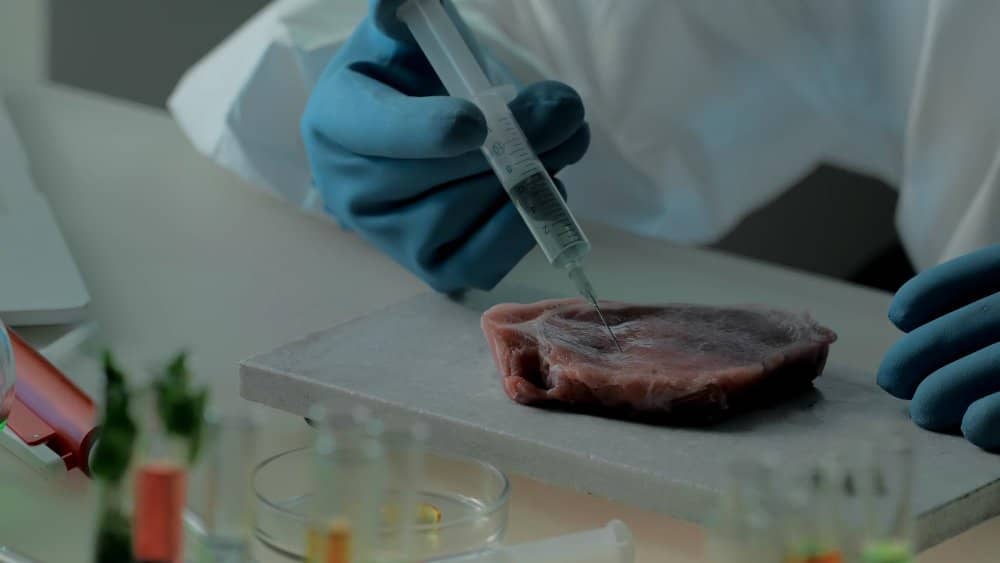The U.S. approves the human consumption of lab-grown chicken meat.
The U.S. food regulatory agency has given the green light for the first time to the commercialization of lab-grown chicken meat in supermarkets and restaurants.
The authorization granted:
The Federal and Drugs Administration (FDA), the U.S. food and drug regulatory agency, has authorized for the first time in its history a lab-grown meat product for human consumption. This authorization applies to chicken meat produced in the facilities of the Californian company Upside Foods and the company Good Meat, which now have approval to bring their products to supermarkets and restaurants in the U.S.
Upside Foods, formerly known as Memphis Meats, will be able to market its lab-grown chicken once the USDA (U.S. Department of Agriculture) has inspected its facilities. The meat is produced by extracting living cells from the animal, which are then placed in stainless steel tanks where they replicate until they form a structure and consistency similar to a chicken fillet.
After evaluating the production and the cultivated cell material used by Upside Foods, the FDA stated that it has “no further questions” regarding the safety of its lab-grown chicken fillet. “The world is experiencing a food revolution, and the U.S. FDA is committed to supporting innovation in the food supply,” said FDA Commissioner Robert Califf and Susan Mayne, director of the FDA’s Center for Food Safety and Applied Nutrition in a statement.
The implementation of this measure marks the beginning of a new era aimed at eliminating animal slaughter and reducing the environmental impacts of grazing, growing food for animals, and animal waste.
“Instead of dedicating so much land and water to feeding animals that will be slaughtered, we can do something different,” said Josh Tetrick, co-founder and CEO of Eat Just, the operator of the multinational Good Meat.
On Wednesday, both companies received approval from the required federal inspectors to sell lab-grown meat and chicken in the U.S.
Additionally, the Food and Drug Administration gave the green light to another manufacturer, Joinn Biologics, which works with Good Meats.
The new lab-grown meat market:
This meat is said to drastically reduce water consumption, land area, and resources used in traditional industrial livestock production. It is also considered more sustainable because it generates less pollution and CO2. It is a global market that has attracted over $2 billion in investments, mainly led by Israel and the U.S.
The Israeli company, Aleph Farms, previously introduced the first rib made with a 3D printer, a significant evolution from the lab-grown ground meat seen so far. Making a steak is much more complicated than recreating ground meat; to replicate a muscle piece, it needs to be given a structure to support it, along with fat and connective tissue. We also have Future Meat, one of the largest lab-grown meat companies in the world, which claims to have a production process that reduces the cost of its chicken breasts from 15 euros to only 6.80 for 450 grams.
The U.S., particularly California, is another place where significant investments are being made in this technology. Three companies: Finless Foods, BlueNalu, and Upside Foods are competing for a share of the cultivated meat market, producing not only chicken, lamb, and beef but also crustaceans and mollusks.
However, there are voices that are less optimistic. French researchers Sghaier Chriki and Jean-François Hocquette published a study titled “The Myth of Cultivated Meat,” questioning whether the industry will be able to artificially produce compounds like hormones and growth factors that are naturally found in animals.
The mass adoption of this type of meat on our tables depends on regulatory agencies. So far, Singapore and the U.S. agencies have taken the path of authorizations, and it is expected that the European agency will do so soon.
More than 150 companies are cultivating meat from animal cells. While the innovation is surprising in the U.S., globally, more than 150 companies are focusing on cultivating meat from cells, not just chicken, but also pork, lamb, fish, and beef, which have a greater environmental impact.
The “lab-grown” chicken is cultivated in steel tanks with cells from a live animal, a fertilized egg, or a special cell bank.
In the case of Upside, the production comes out in large sheets, which are then shaped into chicken cutlets or sausages.
Meanwhile, Good Meat, which already sells lab-grown meat in Singapore, the first country to authorize it in 2020, turns accumulations of chicken cells into ribs, nuggets, and ground meat.
Where to consume the authorized meat:
Nevertheless, this new form of consumption in the United States will not be immediate, nor will it be consumed by everyone.
“Lab-grown chicken is much more expensive than traditional farm-raised chicken. Additionally, it cannot be produced on the same scale as traditional meat,” according to Ricardo San Martín, director of one of the Meat Lab departments at the University of California, Berkeley. For now, companies plan to serve the new food in selected restaurants. In the case of Upside, it has already partnered with the Bar Creen restaurant in San Francisco; while Good Meat’s dishes will be served at the Washington restaurant run by its chef and owner José Andrés. No agreements have yet been made with any supermarket chains.






0 Comments